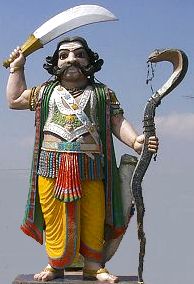|
Angel |
Hinduism, continued.... Foreigners are often not allowed in Hindu temples for reasons mostly related to caste and ritual purity but in Kerala we were taken to visit one. It formed a huge complex, larger than any cathedral I have ever visited, but with one similarity, the various artefacts which, in Hinduism, are mainly images of gods are a miscellaneous assortment that have collected over the ages. To the outside observer the general impression is of a huge garage. This is partly because of the lamp oil which seems to be deliberately smeared all over the walls, but also many temples literally include a garage in which processional carts and floats are simply stacked up in a corner. The temple also looks a bit like a zoo since most of the deities are inside compartments that look a lot like cages or tanks. Worship in Hinduism is much more individualistic than in some other religions. It seems that people might go to the temple at any time, for a wide variety of spiritual purposes. There are priests officiating most of the time but arrangements seem to be made on an individual rather than a collective basis. It is definitely not as if there is a service at 5 pm which everyone will attend, and then leave, though there are festivals at different times throughout the year. Hindu temples and shrines have a strange and powerful atmosphere at any time but one incident occurred during our visit which really brought out this aspect. We were in the shrine to Ganesha when some Hindu women came in to pray. One of them knelt before the deity, then she must have got up too quickly, because she very suddenly collapsed on the floor, and it was a few minutes before she came round. The 'medical' explanation was obvious, but it was still an impressive event in that particular atmosphere. It is easy to imagine that this sort of thing doesn't have to happen very often before rumours about the power of the Ganesha image or the spiritual sensitivity of the individual in question get around. |

